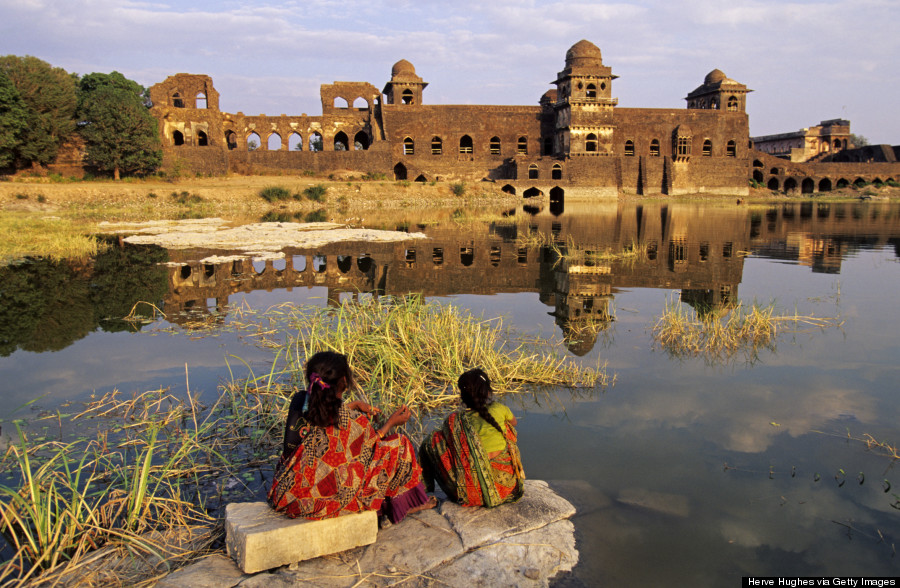India’s beautiful abandoned history
India throughout its history has experienced many different periods. From British Imperialism to the creation of a northern Indian Muslim state, to religious buildings abandoned after migration of people and once prosperous towns left to ruin, every abandoned building and location tells a story of India’s rich heritage.
The abandoned town of Shekhawati.
Lying forgotten in the barren landscapes of the Thar Desert in Rajasthan is the town of Shekhawati, once the home of opulence is now characterized by crumbling grand Havelis. The town’s opulence is etched into the history of the area, with the decadent frescos covering almost every inch of the grand mansions.
Shekhawati was founded in the late 15th century by the eponymous Rajput chieftain Rao Shekha who quickly allowed the town to become prosperous, its peak arriving at the turn of the 19th century. The region lured merchants and caravan trade from Jaipur and Bikaner, which were the nearby commercial centers. As trade grew, merchants from the Marwari and Bania community, a renowned ethnic trading group in India, arrived to set up residence in Shekhawati, and the town felt great prosperity from the flourishing trade in opium, spices, and cotton. As the town and its economy continued to grow, merchant homes gave way to grand decadent mansions, and even when faced with the issue of the money trail moving away to the port towns of Bombay and Calcutta, the merchants simply moved to the new money hub and continued to send home large sums to their homes in Shekhawati. This constant money flow allowed Shekhawati to continue its prosperity. The merchants left no stone untouched in their search to display their great wealth and the frescoes covering most of the Havelis, with inspiration arriving from the 17th-century ochre frescoes introduced by the Rajput Kings of Jaipur in Amer fort. The pictures showcase the rich religious history of India, with scenes from the ancient Hindu epics, accompanied by decorative floral designs and patterns. Later, in the 20th century, the Frescoes began to depict European influences and modern advances that the merchants had encountered on their travels, including frescoes of Queen Elizabeth, Jesus, steam engines and creative scenes where mythology mixes with modern inventions, such as a picture where Hindu gods are in chauffeur driven cars. Although the town had been experiencing great prosperity for many years at the turn of the century, the rich business tycoons abandoned their Havelis, preferring the bustling metropolises like Bombay, Calcutta, or locations lying further afield. As trade moved away, there was little development in the arid lands of Shekhawati and the Havelis were abandoned for good, leaving them to disrepair and the mercy of the towns. Today, in order to protect the homes, two districts within Shekhawati have now banned the sale of Havelis to anyone who may harm their delicate look as the townspeople want to ensure that the town can remain a tourist hub, although the fact that many of these Havelis are still private property do make the upkeep difficult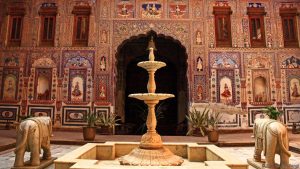
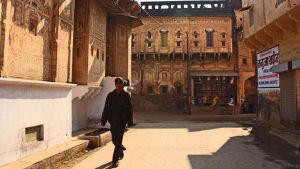
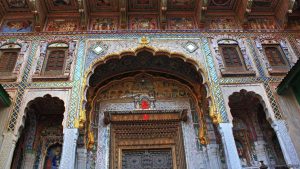
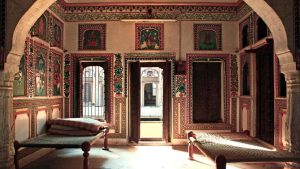
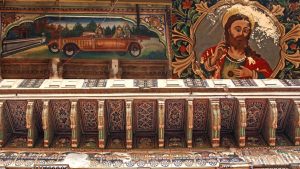
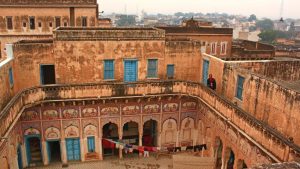
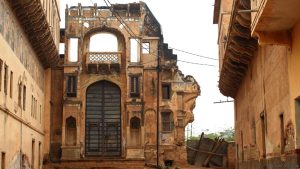
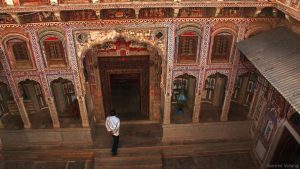
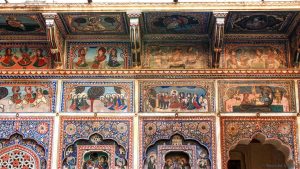
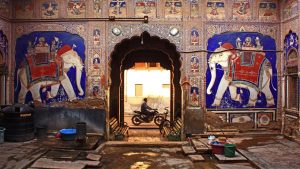
Bhangarh, Rajasthan, India
The beautiful village of Bhangarh in India has been labeled as the most haunted place in Asia, with the main fort as the most haunted area in the village. Nestled between the large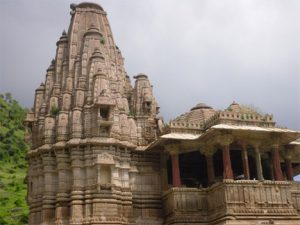 cities of Delhi and Jaipur, the village is hidden away in the lush greenery and rocky cliffs, hiding a rich history rapt with superstition. The village was established in 1573 by a prince, however, by 1630 it had already begun to decline. Finally, it became completely uninhabited by 1783 due to political strife and a great famine. Locals believe that the town was cursed by the Guru Balu Nath, who first condoned the village’s creation. However, Balu Nath warned that “the moment the shadows of your palaces touch me, the city shall be no more!”, and a careless prince, who refused to heed the warning built his palace high enough to cast a shadow, condemned the town to its downfall. Another myth of the town follows the princess of Bhangarh, Ratnavati, whose beauty was a match for no other. Amidst her many matrimonial offers, there arose a Tantrik, a magician of the occult named Singhia, who wished desperately for her hand, knowing that it was impossible for him to even see him. After seeing Ratnavati’s maid in the market buying her scented oil, Singhia used black magic that would cause the princess to be hypnotized merely by touching the oil.
cities of Delhi and Jaipur, the village is hidden away in the lush greenery and rocky cliffs, hiding a rich history rapt with superstition. The village was established in 1573 by a prince, however, by 1630 it had already begun to decline. Finally, it became completely uninhabited by 1783 due to political strife and a great famine. Locals believe that the town was cursed by the Guru Balu Nath, who first condoned the village’s creation. However, Balu Nath warned that “the moment the shadows of your palaces touch me, the city shall be no more!”, and a careless prince, who refused to heed the warning built his palace high enough to cast a shadow, condemned the town to its downfall. Another myth of the town follows the princess of Bhangarh, Ratnavati, whose beauty was a match for no other. Amidst her many matrimonial offers, there arose a Tantrik, a magician of the occult named Singhia, who wished desperately for her hand, knowing that it was impossible for him to even see him. After seeing Ratnavati’s maid in the market buying her scented oil, Singhia used black magic that would cause the princess to be hypnotized merely by touching the oil. 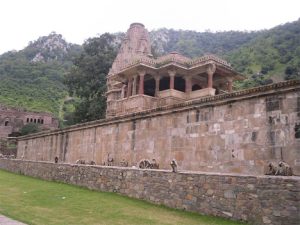 However, the princess found out and threw the oil away where it fell onto a stone, causing it to roll towards the Tantrik and crush him. As the Tantrik lay dying, he cursed the palace with the death of all who dwelt in it, without any rebirth in their destinies. The following year, a great battle between Bhangarh and Ajabgarh occurred and left no survivors. The local people have such great belief in the curse that between dusk and dawn entry is prohibited to the park, with government officials even, refusing to patrol the area nightly, as they maintain that those who enter the park in the prohibited hours disappear. However, the place is still a beautiful tourist area during the day with rich history and decadent signs of India’s heritage.
However, the princess found out and threw the oil away where it fell onto a stone, causing it to roll towards the Tantrik and crush him. As the Tantrik lay dying, he cursed the palace with the death of all who dwelt in it, without any rebirth in their destinies. The following year, a great battle between Bhangarh and Ajabgarh occurred and left no survivors. The local people have such great belief in the curse that between dusk and dawn entry is prohibited to the park, with government officials even, refusing to patrol the area nightly, as they maintain that those who enter the park in the prohibited hours disappear. However, the place is still a beautiful tourist area during the day with rich history and decadent signs of India’s heritage.

Take a tour: https://www.youtube.com/watch?v=SwxGm0lVSPQ
Learn More: https://www.youtube.com/watch?v=R7JNrJITLZQ
Kalavantin Durg
Little is known about the true origins of India’s most dangerous fortress, Kalavantin Durg. Rumours dictate that the fortress was built around 500 BCE, 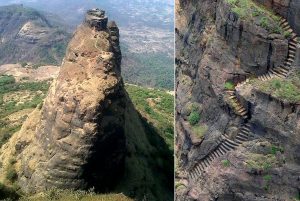 for a queen by the name of Kalavantin, though little is known about her. During the years that followed the local Adivasi people trekked to the top of the fortress, also known as Prabaglad Fort, to celebrate the festival of Holi and used the fortress as a vantage point to protect themselves. The fortress was taken over by the Maratha forces under Shivaji’s rule, who took advantage of the forts on the top of the mountain, but was later abandoned due to its lack of a good water supply source and loss of need for defense.The fortress originally was only accessible by a trek up an almost vertical mountain, although today luckily for tourists, stairs were introduced to make access easier. The trek to an elevation of 2,300 feet is undoubtedly worthwhile as views extend reportedly all the way from the fort’s location, between Matheran and Panvel in Maharashtra, to Mumbai, showcasing the extensive green landscape and natural architecture of India.
for a queen by the name of Kalavantin, though little is known about her. During the years that followed the local Adivasi people trekked to the top of the fortress, also known as Prabaglad Fort, to celebrate the festival of Holi and used the fortress as a vantage point to protect themselves. The fortress was taken over by the Maratha forces under Shivaji’s rule, who took advantage of the forts on the top of the mountain, but was later abandoned due to its lack of a good water supply source and loss of need for defense.The fortress originally was only accessible by a trek up an almost vertical mountain, although today luckily for tourists, stairs were introduced to make access easier. The trek to an elevation of 2,300 feet is undoubtedly worthwhile as views extend reportedly all the way from the fort’s location, between Matheran and Panvel in Maharashtra, to Mumbai, showcasing the extensive green landscape and natural architecture of India.
Take the tour: https://www.youtube.com/watch?v=1s9ul52w2KA
Ross Island British Colony
The British colonial settlement, named Ross Island, has been fully taken over by nature in the years of its abandonment. The settlement lies in the Andaman Islands and was first inhabited by Westerners in 1788. From the beginning, settlers faced great difficulties, including uncooperative weather conditions that led a high mortality rate and the settlement’s fir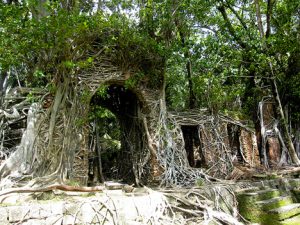 st abandonment. Decades later, in 1887, the settlement was reopened by the British as a jail and penal colony to deal with the Indian Uprisings. Then later in 1942, the colony was invaded by the Japanese, although control was eventually regained by the British who later passed the island onto the Indian Navy during the process of decolonization. The island is now a tourist attrction, and after refurbishment in 1993, brick pathways enabled visitors to safely explore the remains of a colonial Empire. On the island, the fractured remains of old houses, stores, a bazaar, church, swimming pool and a small hospital, as well as Japan’s bunkers, lie dormant as they are slowly enveloped into the wild Ficus plants.
st abandonment. Decades later, in 1887, the settlement was reopened by the British as a jail and penal colony to deal with the Indian Uprisings. Then later in 1942, the colony was invaded by the Japanese, although control was eventually regained by the British who later passed the island onto the Indian Navy during the process of decolonization. The island is now a tourist attrction, and after refurbishment in 1993, brick pathways enabled visitors to safely explore the remains of a colonial Empire. On the island, the fractured remains of old houses, stores, a bazaar, church, swimming pool and a small hospital, as well as Japan’s bunkers, lie dormant as they are slowly enveloped into the wild Ficus plants.
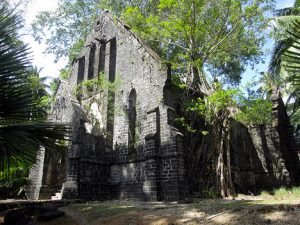
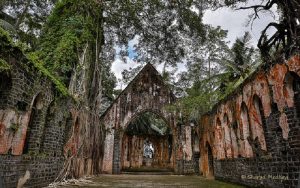
Take the tour: https://www.youtube.com/watch?v=LrV6TVqHjJE
Ancient Mandu
The capital city of the northern Indian Muslim state found a home in Mandu between 1401 and 1561. The ancient settlement of Mandu, atop at 20 km2 plateau, lies in the Malwa region of western Madhya Pradesh, the fortress town encompassing preserved ornate stone mosques, palaces, Jain temples and other structures, all encircled by a battlemented wall. 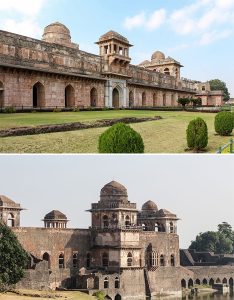 The location was strategic to its rulers and so often changed hands as locals fought over its forts and viewpoint. The earliest known record of the fort was found in Sanskrit inscriptions on the pedestal of a Jain image, Jain being the sixth-largest practiced religion in India, dating to 555 AD. Later in the 16th century, a Persian historian notes that a fort, around the end of the 6th century AD, was built in Mandu. The following reference arrives around 300 years later in 946 AD, where Mandu is referred to as a frontier output of the Gu Hara-Pratihara Empire, although the fort quickly changed hands into those of the Parmara dynasty, changing the face of the fortress. When Muslim forces invaded the fortress in the early 13th century, the cities of Bhilsa and Ujjain were ravaged, although Mandu was spared and added to the sultan’s territories, being renamed the City of Joy. Once the Delhi Sultanate
The location was strategic to its rulers and so often changed hands as locals fought over its forts and viewpoint. The earliest known record of the fort was found in Sanskrit inscriptions on the pedestal of a Jain image, Jain being the sixth-largest practiced religion in India, dating to 555 AD. Later in the 16th century, a Persian historian notes that a fort, around the end of the 6th century AD, was built in Mandu. The following reference arrives around 300 years later in 946 AD, where Mandu is referred to as a frontier output of the Gu Hara-Pratihara Empire, although the fort quickly changed hands into those of the Parmara dynasty, changing the face of the fortress. When Muslim forces invaded the fortress in the early 13th century, the cities of Bhilsa and Ujjain were ravaged, although Mandu was spared and added to the sultan’s territories, being renamed the City of Joy. Once the Delhi Sultanate
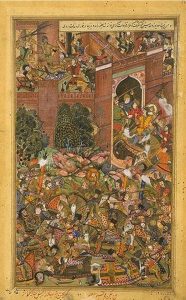
descended into chaos, the governor of Malwa declared independence in 1401, and shifted the capital to Mandu, allowing for new architectural developments, including the new and first Indo-Islamic building in Mandu. Decline began after the Mughals conquered in 1561, stripping the city of its status and former glory. The city was pillaged by the Mughals and left to its slow ruin, although it remained forever a place of fascination for the Emperor Akbar who visited the city several times, leaving many detailed descriptions of the city in his memoirs.
The Jahaz Mahal, as it was nicknamed the ShipPleasurePalace, is one of the stunning pieces of architecture in Mandu and is located between two artificial lakes, giving the impression that it’s floating on the water. Rumour has it that within the wall of the palace the founder, Ghiyasuddin, who was a devout hedonist, had a harem of 15,000 women, some serving as bodyguards, originating from regions as far as Turkey and Abyssinia.

The Mausoleum of Hoshang Shah is another key point of interest, with rumours that served as the template for the future construction of the Taj Mahal, built by Hoshang Shah, who served as the first formally appointed Islamic King of the Malwa region of India and marked the predominance of Muslim traditions.
Take the tour: https://www.youtube.com/watch?v=lWNK3ueE81Q
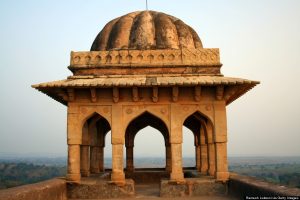
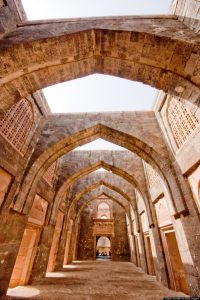
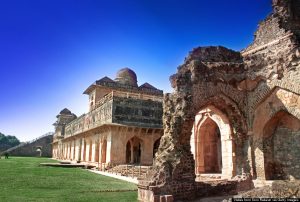
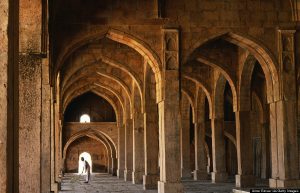
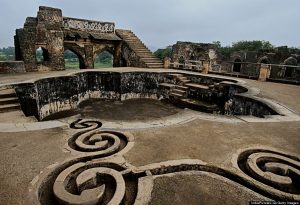
Fatehpur Sikri Ghost Town
Fatehpur Sikri was the capital of the Mughal Empire, founded in 1569 by Emperor Akbar, and
sits atop a rocky ledge with the dramatic 177-foot high entrance way leading to a beautifully preserved town, built from the locally quarried red sandstone. The town’s name translates to the City of Victory but was only the empire’s capital for 10 years. A lack of water and safety, as well the town’s overwhelming proximity to areas in turmoil, led to the downfall of the great Empire’s capital and its abandonment by 1585. Fatehpur Sikri is now a UNESCO world heritage site, located in the Agra District in the State of Uttar Pradesh, northeastern India, next to an artificial lake and sloping levels of the outcrops of the Vindhyan hill ranges. The city has barely been touched, with the great royal palaces, courts, mosque harem and other buildings preserved, showcasing the diversity of the city.
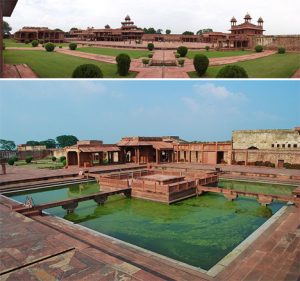
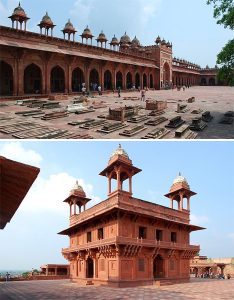
Take a tour:https://www.youtube.com/watch?v=mqY4Xpzr1L4
Vijaynagara, Karnataka
The former “Rome” of India, the city of Vijaynagara was once called home by 500,000 and stood as the second-largest city in the world at its peak. The town had originated from the work of two brothers, Harihara I and Bukka Raya, who laid the city’s foundations on the south ba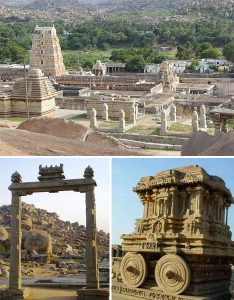 nk of the River Tungabhadra. The kingdom was relatively peaceful as though they strictly worshiped the Hindu gods but remained tolerant towards the other religions and collaborated well with the neighboring kingdoms. The kingdom’s glory peaked in 1500, where it was globally renowned and labeled by a Portuguese visitor as “the best-provided city in the world”, ruling for 300 years over a large Hindu kingdom. Throughout its dynasty, the Sangama dynasty was known both for their heavy influence on the development of music, literature, architecture, and their positive impact on the economy, which was prosperous to the extent that new coins had to be introduced during the empire’s existence. However the powerful city suffered a debilitating defeat of its army in 1565 under the Tuluva Dynasty, and the stronger Muslim power razed, depopulated and destroyed the city. The city, so ravaged, stepped backward in time to a more primitive way of life where they became dependent on agriculture and the city eventually fell into such great ruin that it was abandoned. The surrounding area has seen rapid growth with the installment of two hydroelectric facilities in the 20th century, with a population today of around 2.5 million, yet the once great city of Vijay Nagara remains abandoned.
nk of the River Tungabhadra. The kingdom was relatively peaceful as though they strictly worshiped the Hindu gods but remained tolerant towards the other religions and collaborated well with the neighboring kingdoms. The kingdom’s glory peaked in 1500, where it was globally renowned and labeled by a Portuguese visitor as “the best-provided city in the world”, ruling for 300 years over a large Hindu kingdom. Throughout its dynasty, the Sangama dynasty was known both for their heavy influence on the development of music, literature, architecture, and their positive impact on the economy, which was prosperous to the extent that new coins had to be introduced during the empire’s existence. However the powerful city suffered a debilitating defeat of its army in 1565 under the Tuluva Dynasty, and the stronger Muslim power razed, depopulated and destroyed the city. The city, so ravaged, stepped backward in time to a more primitive way of life where they became dependent on agriculture and the city eventually fell into such great ruin that it was abandoned. The surrounding area has seen rapid growth with the installment of two hydroelectric facilities in the 20th century, with a population today of around 2.5 million, yet the once great city of Vijay Nagara remains abandoned.
Take a tour: https://www.youtube.com/watch?v=yN7P2qefiFk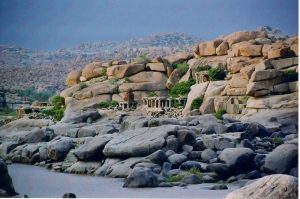
The village of death – Kuldhara, Rajasthan
The Village of Death is situated about 15km west of Jaisalmer, a city in western Rajasthan and is officially known as Kuldhara village. The settlement was planned in a grid-like fashion. with wide streets and houses opening into them. Both aesthetics and utility were at the forefront of the designer’s priorities. Over the centuries of its existence, the town prospered from its ability to grow bumper crops in the arid desert, and so, temples, step wells and other structures, all demonstrating the village’s steady development, were built for the thriving population. 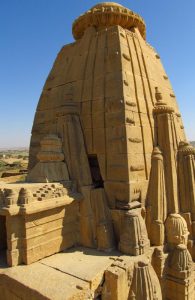 Kuldhara eventually grew to be the largest village in the community of 84 after its establishment in 1291 by the Paliwal Brahmins. However, the mystery surrounding the village remains about where the townspeople went. In 1825 the village of Kuldhara and the neighboring 83 villages all appeared to vanish in overnight after residing there for over 7 centuries. One theory is that the evil dewan, or minister, in the ruling Kingdom saw the village’s chief young daughter and wanted instantly to marry her. The king, in his attempt to forcefully marry the chief’s daughter, gave the village a deadline where he would eventually arrive and steal her away. The chiefs’ of the 84 villages then met together and for the sake of pride and honour, decided to leave the village together and escape the wrath of the king. To this day, it remains uncertain where the population went, with most presuming they settled near Jodhpur in another city in western Rajasthan and locals are fearful that the departed villagers left a curse over the village, warning that anyone who tries to inhabit this land would soon have death brought upon them. It is now a government-protected historical site that reflects the almost forgotten ways of life.
Kuldhara eventually grew to be the largest village in the community of 84 after its establishment in 1291 by the Paliwal Brahmins. However, the mystery surrounding the village remains about where the townspeople went. In 1825 the village of Kuldhara and the neighboring 83 villages all appeared to vanish in overnight after residing there for over 7 centuries. One theory is that the evil dewan, or minister, in the ruling Kingdom saw the village’s chief young daughter and wanted instantly to marry her. The king, in his attempt to forcefully marry the chief’s daughter, gave the village a deadline where he would eventually arrive and steal her away. The chiefs’ of the 84 villages then met together and for the sake of pride and honour, decided to leave the village together and escape the wrath of the king. To this day, it remains uncertain where the population went, with most presuming they settled near Jodhpur in another city in western Rajasthan and locals are fearful that the departed villagers left a curse over the village, warning that anyone who tries to inhabit this land would soon have death brought upon them. It is now a government-protected historical site that reflects the almost forgotten ways of life.
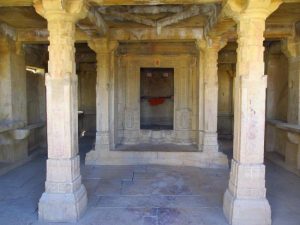
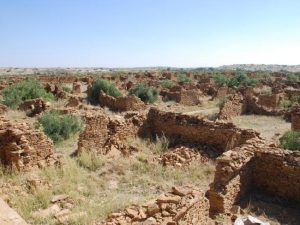
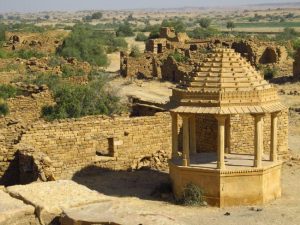

Shettihalli Church, Hassan District, Karnataka
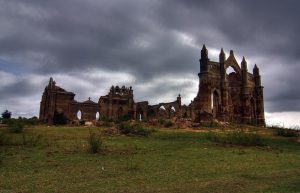 The Shettihalli Church was built in the 1800s by French missionaries and is one of the places standing testament to the ethereal beauty of abandoned places of worship. The strength of the church is highly admirable as it has not yet succumbed to the flow and ebb of the Hemavathi river, which routinely submerges it. When the church was built, the hamlet was lush with fruitful sunflower fields, surrounding an idyllic village. The church had been built by the French for British Estate owners in Alur and Sakleshpur to increase the town’s prosperity. However, the village was lost to development when the Hemavathy reservoir was built at Group with the aim of developing agriculture in the neighboring towns, but resulting in a flood of the area surrounding the church. The reservoir was successful in irrigating land in Hassan, Tumkur, and Mandya district at the eternal cost of the idyllic village.
The Shettihalli Church was built in the 1800s by French missionaries and is one of the places standing testament to the ethereal beauty of abandoned places of worship. The strength of the church is highly admirable as it has not yet succumbed to the flow and ebb of the Hemavathi river, which routinely submerges it. When the church was built, the hamlet was lush with fruitful sunflower fields, surrounding an idyllic village. The church had been built by the French for British Estate owners in Alur and Sakleshpur to increase the town’s prosperity. However, the village was lost to development when the Hemavathy reservoir was built at Group with the aim of developing agriculture in the neighboring towns, but resulting in a flood of the area surrounding the church. The reservoir was successful in irrigating land in Hassan, Tumkur, and Mandya district at the eternal cost of the idyllic village.

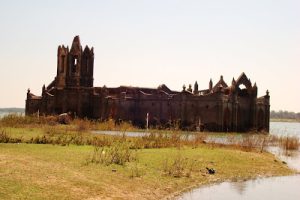
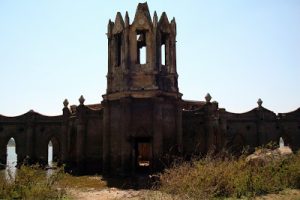
Take a tour: https://www.youtube.com/watch?v=pebcaKFB18E
- Written by Phoebe Thomas
Photographers
- Tomas Belcik (Kuldhara)
- Anon – Backpakker (Shettihalli)
- Teambhp (Shettihalli)
- Wikimedia (Fatehpur)
- Nikita Smits (Vijaynagara)
- Sharad Medhavi (Ross Island)
- Mridula (Kudlhara)
- SA Rogers (Various)
































































